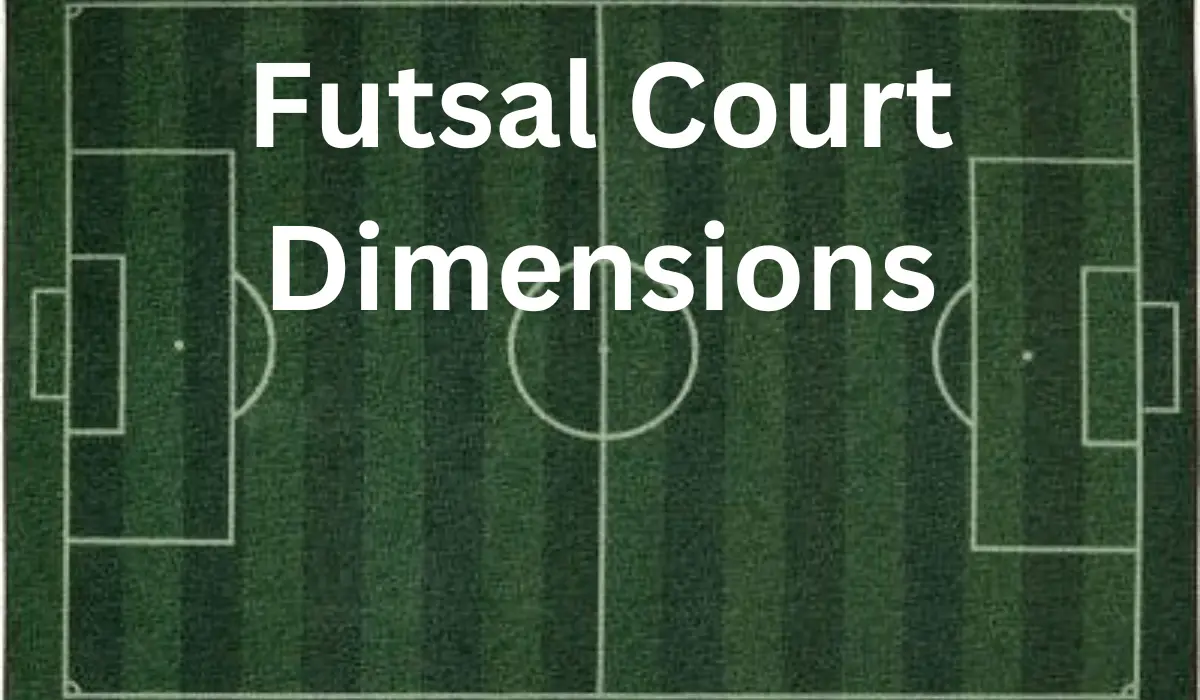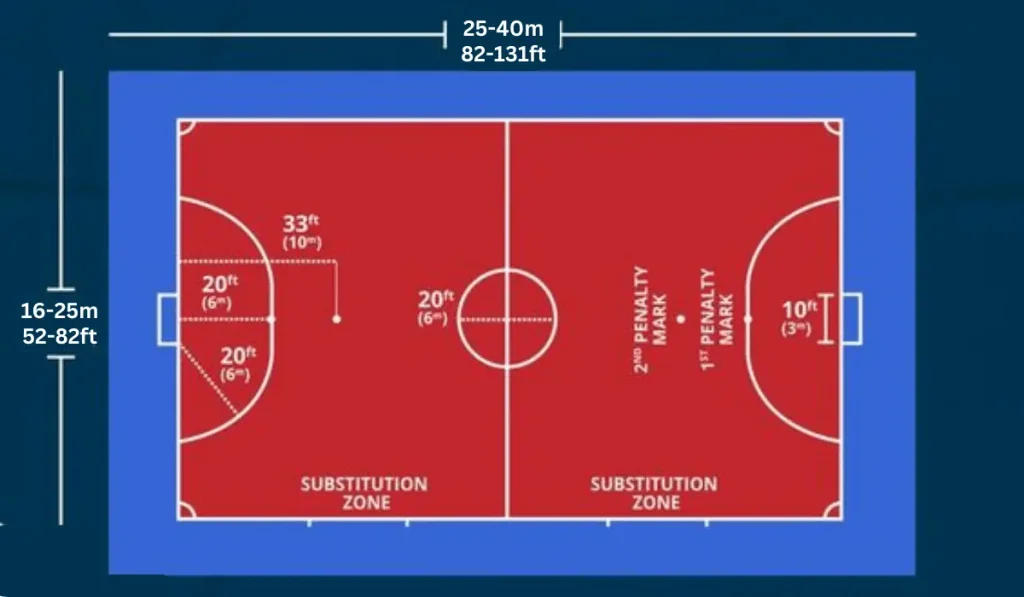Dimensions of Futsal Court – Futsal Ground Size

In the electrifying world of futsal, where agility, precision, and split-second decisions reign supreme, the dimensions of the court play a pivotal role in shaping the game’s unique dynamics. This fast-paced variant of the beautiful game demands exceptional ball control and tactical awareness from players as they navigate the compact, hardwood battleground.
The futsal court dimensions are meticulously designed to foster a high-intensity, technical style of play, with international matches adhering to strict standards:
| Court Type | Length | Width |
|---|---|---|
| International | 38-42 meters | 20-25 meters |
| Domestic | 25-42 meters | 15-25 meters |
These carefully crafted measurements create a canvas where every touch, every pass, and every movement carries heightened significance. The smooth, shiny surface, often made of:
- Wood
- Artificial material
Allows for lightning-quick transitions and dazzling displays of skill, with the screeching of shoes serving as the soundtrack to the on-court artistry.
Mastering ball control in these tight spaces is paramount, as players must navigate the compact court with precision, flair, and an innate understanding of the game’s dynamics. Futsal icons like:
- Falcao
- Ricardinho
Have elevated this art form to new heights, inspiring generations of players to perfect their technique and become masters of the futsal court.
repair to etch your name among the futsal greats who have graced these hallowed hardwood battlegrounds.
Standard Futsal Court Dimensions

When it comes to futsal court sizes, one size does not fit all! The dimensions can vary quite a bit depending on the level and type of match being played.
For international competitions with pros squaring off, you’ll see full-scale courts that are about 38-42 meters long and 20-25 meters wide. This allows plenty of space for delicate passes and dynamic play.
For amateur pickup games, the court may be a quarter of that size – but the action is just as intense! Youth and school matches will be somewhere in between. Court markings also transform the space with lines highlighting key zones like penalty areas and substitution boxes.
So whether you’re in a full indoor gym or a back-alley driveway, the standard futsal court has just enough room for technical skill and lots of goals. It’s amazing how futsal adapts to each unique space, yet keeps the rhythm of fast footwork and tight control. That flexibility helps fuel futsal’s rise across the globe!
Court for International Matches
For official futsal leagues and matches, the court dimensions must meet certain regulations. The length should range from a minimum of 38 meters up to a maximum of 42 meters. The width should fall between 20 and 25 meters.
This results in a total playing area that is at least 760 square meters but no more than 1050 square meters. The internationally approved court size is typically 40 meters long by 20 meters wide, giving an area of 800 square meters.
| International Matches |
|---|
| Length: Minimum 38m, Maximum 42m |
| Width: Minimum 20m, Maximum 25m |
| Total Area: Minimum 760 sq m, Maximum 1050 sq m |
The run-off space around the court should be 3m.
These larger court dimensions allow for dynamic, competitive futsal at the international level. There should also be a 3-meter clear space around the court boundaries for player safety because intense players can collide near the lines and the chances of getting injured are more.
Court for Non-International Matches
For domestic games, the court dimensions can be smaller. The length ranges from a minimum of 25 meters up to 42 meters maximum. The width falls between 16 and 25 meters wide.
This leads to a total playing area of anywhere from 400 square meters to 1050 square meters. Typical court sizes are 30×15 meters or 20×40 meters. The run-off space around a non-international court should be at least 2 meters wide.
| Non-International Matches |
|---|
| Length: Minimum 25m, Maximum 42m |
| Width: Minimum 16m, Maximum 25m |
| Total Area: Minimum 400 sq m, Maximum 1050 sq m |
Minimum run-off space is 2m.
Smaller courts allow amateur and youth players more time to engage with the ball. The dimensions can be adapted based on available space and then accordingly you can also divide the number of players because it’s flexible as it’s not official.
Futsal Court Lines and Markings
The futsal court comes to life through its proper markings that guide how to play and strategize. The halfway line splits the court down the middle, while the center circle provides a focal starting point and return point after goals are scored.
These create order in intense action during gameplay. The penalty areas and penalty marks are the important zones that determine free kicks and penalties when rules are broken or fouls are being committed. Corner arcs give targets for thrilling set pieces and delightful moves.
In the hands of skilled players, these markings almost become instruments to create a creative movement and passing. Touchlines provide barriers for close control and dizzying footwork and shock the opposite team.
| Futsal Court Lines and Markings |
|---|
| Touchlines The 2 longer boundary lines on the sides |
| Goal Lines The 2 shorter lines on the ends where the goals are placed |
| Halfway Line Divides the court into 2 halves |
| Centre Circle With a 3m radius, marked around the center mark |
| Penalty Areas Quarter circles with a 6m radius from each goalpost |
| Penalty Marks Spots 6m and 10m from the mid-point of each goal line |
| Substitution Zones 5m long zones on the touchline for player changes |
| Corner Arcs 25cm radius quarter circles in each corner |
The constant interplay with court boundaries allows clever dribblers to find new angles. Posts offer pivots for sudden changes in direction. The boxed-in pitch concentrates play into a compact environment where technical mastery, ball control, and quick twists and turns are essential.
This is where futsal is transformed from chaotic street kickabouts into a serious game of tactics and finesse worthy of a worldwide audience. The markings elevate futsal into a thinking player’s game demanding skill, creativity, and split-second decision-making.
The Futsal Court Goals
Futsal goals are a more compact version compared to football, designed to fit the reduced court dimensions. They are placed centrally on the goal lines, consisting of two vertical posts connected by a horizontal crossbar like a football goal.
| The Futsal Court Goals |
|---|
| Distance between posts: 3m |
| Height from ground to crossbar: 2m |
| Goal posts and crossbar thickness: 8cm |
| Net depth: Minimum 80cm at top, 100cm at bottom |
Regulations state the posts must be 3 meters apart and the crossbar should be 2 meters high off the ground. Both the posts and crossbar are typically 8cm thick. Nets with a minimum depth of 80cm on top and 100cm on bottom attach to the back of the goal frame to absorb hard-struck shots.
Quality futsal goals feature rectangular steel tube frames and net hooks to maintain structural balance during games. Portable goals with wheels or folding bases make setting up courts easier. Though smaller than football goals, well-made futsal goals still are the magical target for players striving to hit.
Futsal Court Features and Zones
As I walk into a futsal arena for my first international futsal tournament, I’m taking in all the details that make up this intense court. The thin lines mark out the boundaries and zones, but it’s the special features that catch my eye.
The 5-meter substitution areas on the sides are where I’ll enter the game, ready to sprint into the action. The timekeeper’s table at midfield, surrounded by open space, is the futsal equivalent of a referee’s pitchside bunker.
| Futsal Court Features and Zones |
|---|
| Substitution Zones 5m long areas on touchline for substitutions |
| Timekeeper’s Table 5m either side of halfway line kept clear |
| Spectator Area 3m wide safety area around court |
| Ceiling Height At least 4m for international matches |
The 3-meter perimeter keeps avid fans like me safely back from the play. When the ball hits the ceiling 4 meters above, I’m reminded this game is played on a much more intimate scale than football because of its fast pace it gets more and more exciting.
Every detail of the court is designed to create the fast-paced, technical style of play I love. As players took the court, I was eager to experience how these international athletes use every meter to their advantage.
Futsal Court Surface Materials
Having played futsal on courts made of various materials, I’ve experienced firsthand their unique properties. Wood floors provide a true bounce that’s ideal for controlled passing. Synthetic surfaces like Sports Court are softer for knees but maintain speed.
| Futsal Court Surface Materials |
|---|
| Wood floors |
| Synthetic floors |
| Concrete with applied surface layer |
| Rubber floors |
| Smooth asphalt |
Concrete with an overlay takes paint nicely but can be abrasive if not smoothed out. My favorite is urethane rubber floors that combine cushioning with a standardized futsal ball size and bounce. Whatever the subsurface, a quality top layer helps meet the demands of fast futsal play.
Court Dimensions for Youth and Amateur Games
| U-17 and U-15 Boys | Women’s and Girls Futsal |
|---|---|
| Length: Minimum 36m | Length: 32m |
| Width: Minimum 18m | Width: 16m |
| Run-off: Minimum 1.5m | Run-off: Minimum 1.5m |
As a longtime player and coach, I’ve seen how modifying court sizes benefits young athletes. For U-15 and U-17 boys, lengths of 36 meters and widths of 18 meters with just 1.5-meter run-offs are standard. Similarly, women’s and girls’ matches use the almost same compact dimensions.
These smaller spaces keep players engaged and active with more touches on the ball. Younger players develop their close control and pass much faster. Now as a coach, I design drills to take advantage of the full court even with 5-year-olds.
Tighter game parameters force kids to make quicker decisions and anticipate pressure. By progressing to full-size courts as teenagers, futsal players gain maturity beyond their years. The nuanced court dimensions help build technical mastery from a young age.
Finding the Right Futsal Court Size
When setting up a futsal court, consider the level of play and available space. Allow sufficient run-off space between the boundaries and walls/spectators for safety.
For amateur games, a court size around 25m x 15m or 30m x 15m is common. U-17 and women’s matches can be played on 36m x 18m. Premier standard is 38-42m x 20-25m.
Regulation international matches require a court measuring 40m x 20m with a 3m run-off. However, competitive games can still be played on slightly smaller courts.
Futsal Court Layout Plans of Dimensions and Size
When planning a futsal court for your club or constructing arenas to host tournaments, having access to the official court diagrams is invaluable. FIFA provides detailed layouts showing precise measurements for all lines, zones, circles, and arcs.
National federations also give specifications tailored to their standard court sizes. Builders use computer-aided design (CAD) software to map courts down to the centimeter based on regulations. Knowing the guidelines helps managers rent facilities of regulation size.
With portable goals, even unconventional spaces can be transformed into futsal pitches. However optimal courts designed around the standardized dimensions will always bring out the best in talented futsal players. They allow room for maneuvers like the Elastico and Rabona that electrify fans.
Get the layout right, and your futsal court will be both officially compliant and engineered for skills, speed, and maximum excitement for players as well as spectators.
Futsal Court Positions and Zones
The futsal court is a dynamic arena where each zone and futsal position has a strategic purpose. As a lifelong player, the nuances of spatial tactics have always fascinated me.
The goalkeeper rules over their penalty box kingdom, able to use hands only in this area. Outside, my pivot orchestrates play from the middle, pulling strings like a futsal puppet master. Up front, the lightning-fast striker runs on any through balls in the channels.
Wingers race up and down the touchlines, stretching the defense wide open. One well-timed cross finds my perfectly-timed run for a volley goal just like in practice. Backpedaling defenders cut off attackers, shepherding them out wide. Though compact, the court becomes an intense battlefield.
Zones give structure, but elite players break free using feints, pivots, and clever off-ball movement. Space opens up where none existed seconds before. The court transforms into an instrument played by those who have mastered futsal drills.
It’s a game of perpetual motion bounded by lines – but one where creative spatial play leaves defenders frozen and unmoved. How exhilarating it is to experience futsal’s fluidity firsthand is just a lifetime experience both playing and watching.
Corners, Free Kicks, and Penalties Spots in Futsal
Futsal’s court markings do more than just delineate boundaries – they provide targets for thrilling set pieces. Corner arcs give whip-smart players a channel to aim dangerous inswinging crosses. Standing on the penalty spot, I feel alive knowing it’s just me against the keeper from this deadliest of scoring zones.
When the referee signals an accumulated foul, the attacking team gains a huge advantage. All rival players must retreat outside the free kick circle, as I line up a direct blast 10 meters from the goal. With a well-struck ball, these restarts can be match-winners!
Mastering placement from the marked zones separates good players from the truly great. Curving the ball just inside the post, unleashing an unstoppable rocket, or finding a teammate unmarked in the area – precision and creativity are key. For fans, seeing shots ripple the net from these set-pieces is a moment of suspense and joy.
Futsal’s court markings keep gameplay flowing quickly. But used wisely, these restart markers become targets for scoring, injecting added drama into the game. They exemplify how futsal rewards intelligent play as much as athleticism alone.
Conclusion of Futsal Court Dimesnions
From the grandest international stages to local amateur matches, the dimensions of the futsal court are carefully crafted to foster a dynamic, skill-driven game that demands technical mastery. The smaller pitch places a greater emphasis on:
- Ball control
- Quick thinking
- Precise execution
Pushing players to the limits of their abilities.
Understanding the standard court size, zone markings, and layout is crucial for those looking to excel in futsal, whether as players or organizers setting up regulation courts. Governing bodies like FIFA and national federations provide detailed guidelines and layout plans, ensuring consistency and adherence to the game’s established standards.
Futsal played on well-designed courts is a spectacle to behold, captivating audiences with its:
✨ High-intensity action ✨ Displays of skill
For players, this demanding game serves as a training ground for honing essential skills like:
- Touch
- Control
- Passing
- Footwork
Attributes that seamlessly transfer to the outdoor soccer pitch.
As futsal’s global appeal continues to soar, the quality of play on courts marked to official dimensions will only rise, further elevating the sport’s status and cementing its place as a breeding ground for technical excellence.
Embrace the compact court, master its unique challenges, and p
